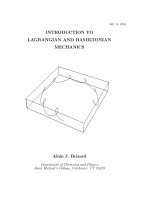Introduction to CPLD and FPGA design
Bạn đang xem bản rút gọn của tài liệu. Xem và tải ngay bản đầy đủ của tài liệu tại đây (1008.49 KB, 40 trang )
Introduction to CPLD and FPGA Design
By Bob Zeidman
President
The Chalkboard Network
www.chalknet.com
Introduction to FPGA Design
1
1. INTRODUCTION
Field Programmable Gate Arrays (FPGAs) are becoming a critical part of
every system design. Many vendors offer many different architectures and
processes. Which one is right for your design? How do you design one of these
so that it works correctly and functions as you expect in your entire system?
These are the questions that this paper sets out to answer.
The first sections of this paper deals with the internal architecture and
characteristics of these devices. Programmable logic devices are described in
an overview, leading up to a detailed description of the Field Programmable
Gate Array. The various architectures of these devices are examined in detail
along with their tradeoffs, which allow you to decide which particular device
is right for your design.
The next sections of this paper is about the design flow for an FPGA-
based project. This section describes the phases of the design that need to be
planned. This allows a designer or project manager to allocate resources and
create a schedule.
The final sections of this paper discuss in detail, the design, simulation,
and testing issues that arise when designing an FPGA. Understanding these issues
will allow you to design a chip that functions correctly in your system and will
be reliable throughout the lifetime of your product.
2. THE MASKED GATE ARRAY ASIC
An Application Specific Integrated Circuit, or ASIC, is a chip that can be
designed by an engineer with no particular knowledge of semiconductor physics
or semiconductor processes. The ASIC vendor has created a library of cells and
functions that the designer can use without needing to know precisely how
these functions are implemented in silicon. The ASIC vendor also typically
supports software tools that automate such processes as synthesis and circuit
layout. The ASIC vendor may even supply application engineers to assist the
ASIC design engineer with the task. The vendor then lays out the chip, creates
the masks, and manufactures the ASICs.
The gate array is an ASIC with a particular architecture that consists of
Introduction to FPGA Design
2
rows and columns of regular transistor structures. Each basic cell, or gate,
consists of the same small number of transistors which are not connected. In
fact, none of the transistors on the gate array are initially connected at all. The
reason for this is that the connection is determined completely by the design
that you implement. Once you have your design, the layout software figures out
which transistors to connect. First, your low level functions are connected
together. For example, six transistors could be connected to create a D flip-
flop. These six transistors would be located physically very close to each other.
After your low level functions have been routed, these would in turn be
connected together. The software would continue this process until the entire
design is complete. This row and column structure is illustrated in Figure 1.
The ASIC vendor manufactures many unrouted die which contain the
arrays of gates and which it can use for any gate array customer. An integrated
circuit consists of many layers of materials including semiconductor material
(e.g., silicon), insulators (e.g., oxides), and conductors (e.g., metal). An
unrouted die is processed with all of the layers except for the final metal layers
that connects the gates together. Once your design is complete, the vendor
simply needs to add the last metal layers to the die to create your chip, using
photomasks for each metal layer. For this reason, it is sometimes referred to as
a Masked Gate Array to differentiate it from a Field Programmable Gate Array.
Figure 1 Masked Gate Array Architecture
3. THE EVOLUTION OF PROGRAMMABLE DEVICES
Programmable devices have gone through a long evolution to reach the
complexity that they have today. The following sections give an approximately
chronological discussion of these devices from least complex to most complex.
Introduction to FPGA Design
3
3.1 Programmable Read Only Memories (PROMs)
Programmable Read Only Memories, or PROMs, are simply memories that
can be inexpensively programmed by the user to contain a specific pattern.
This pattern can be used to represent a microprocessor program, a simple
algorithm, or a state machine. Some PROMs can be programmed once only.
Other PROMs, such as EPROMs or EEPROMs can be erased and programmed
multiple times.
PROMs are excellent for implementing any kind of combinatorial logic
with a limited number of inputs and outputs. For sequential logic, external
clocked devices such as flip-flops or microprocessors must be added. Also,
PROMs tend to be extremely slow, so they are not useful for applications where
speed is an issue.
3.2 Programmable Logic Arrays (PLAs)
Programmable Logic Arrays (PLAs) were a solution to the speed and input
limitations of PROMs. PLAs consist of a large number of inputs connected to an
AND plane, where different combinations of signals can be logically ANDed
together according to how the part is programmed. The outputs of the AND
plane go into an OR plane, where the terms are ORed together in different
combinations and finally outputs are produced. At the inputs and outputs there
are typically inverters so that logical NOTs can be obtained. These devices can
implement a large number of combinatorial functions, though not all possible
combinations like a PROM can. However, they generally have many more inputs
and are much faster.
AND
plane
OR
plane
Inputs
Outputs
Introduction to FPGA Design
4
Figure 2 PLA Architecture
3.3 Programmable Array Logic (PALs)
The Programmable Array Logic (PAL) is a variation of the PLA. Like the
PLA, it has a wide, programmable AND plane for ANDing inputs together.
However, the OR plane is fixed, limiting the number of terms that can be ORed
together. Other basic logic devices, such as multiplexers, exclusive ORs, and
latches are added to the inputs and outputs. Most importantly, clocked
elements, typically flip-flops, are included. These devices are now able to
implement a large number of logic functions including clocked sequential logic
need for state machines. This was an important development that allowed PALs
to replace much of the standard logic in many designs. PALs are also extremely
fast.
Figure 3 PAL Architecture
3.4 CPLDs and FPGAs
Ideally, though, the hardware designer wanted something that gave him
or her the flexibility and complexity of an ASIC but with the shorter turn-around
time of a programmable device. The solution came in the form of two new
devices - the Complex Programmable Logic Device (CPLD) and the Field
Programmable Gate Array. As can be seen in Figure 4, CPLDs and FPGAs bridge
the gap between PALs and Gate Arrays. CPLDs are as fast as PALs but more
complex. FPGAs approach the complexity of Gate Arrays but are still
Introduction to FPGA Design
5
programmable.
Figure 4 Comparison of CPLDs and FPGAs
3.5 Complex Programmable Logic Devices (CPLDs)
Complex Programmable Logic Devices (CPLDs) are exactly what they
claim to be. Essentially they are designed to appear just like a large number of
PALs in a single chip, connected to each other through a crosspoint switch They
use the same development tools and programmers, and are based on the same
technologies, but they can handle much more complex logic and more of it.
3.5.1 CPLD Architectures
The diagram in Figure 5 shows the internal architecture of a typical
CPLD. While each manufacturer has a different variation, in general they are all
similar in that they consist of function blocks, input/output block, and an
interconnect matrix. The devices are programmed using programmable
elements that, depending on the technology of the manufacturer, can be
EPROM cells, EEPROM cells, or Flash EPROM cells.
Introduction to FPGA Design
6
Figure 5 CPLD Architecture
3.5.1.1 Function Blocks
A typical function block is shown in Figure 6. The AND plane still exists as
shown by the crossing wires. The AND plane can accept inputs from the I/O
blocks, other function blocks, or feedback from the same function block. The
terms and then ORed together using a fixed number of OR gates, and terms are
selected via a large multiplexer. The outputs of the mux can then be sent
straight out of the block, or through a clocked flip-flop. This particular block
includes additional logic such as a selectable exclusive OR and a master reset
signal, in addition to being able to program the polarity at different stages.
Usually, the function blocks are designed to be similar to existing PAL
architectures, such as the 22V10, so that the designer can use familiar tools or
even older designs without changing them.
Introduction to FPGA Design
7
Figure 6 CPLD Function Block
3.5.1.2 I/O Blocks
Figure 7 shows a typical I/O block of a CPLD. The I/O block is used to
drive signals to the pins of the CPLD device at the appropriate voltage levels
with the appropriate current. Usually, a flip-flop is included, as shown in the
figure. This is done on outputs so that clocked signals can be output directly to
the pins without encountering significant delay. It is done for inputs so that
there is not much delay on a signal before reaching a flip-flop which would
increase the device hold time requirement. Also, some small amount of logic is
included in the I/O block simply to add some more resources to the device.
Figure 7 CPLD Input/Output Block
Introduction to FPGA Design
8
3.5.1.3 Interconnect
The CPLD interconnect is a very large programmable switch matrix that
allows signals from all parts of the device go to all other parts of the device.
While no switch can connect all internal function blocks to all other function
blocks, there is enough flexibility to allow many combinations of connections.
3.5.1.4 Programmable Elements
Different manufacturers use different technologies to implement the
programmable elements of a CPLD. The common technologies are Electrically
Programmable Read Only Memory (EPROM), Electrically Erasable PROM
(EEPROM) and Flash EPROM. These technologies are similar to, or next
generation versions of, the technologies that were used for the simplest
programmable devices, PROMs.
3.5.2 CPLD Architecture Issues
When considering a CPLD for use in a design, the following issues should
be taken into account:
1. The programming technology
• EPROM, EEPROM, or Flash EPROM? This will determine the
equipment needed to program the devices and whether they
came be programmed only once or many times.
2. The function block capability
• How many function blocks are there in the device?
• How many product and sum terms can be used?
• What are the minimum and maximum delays through the logic?
• What additional logic resources are there such as XNORs, ALUs,
etc.?
• What kind of register controls are available (e.g., clock
enable, reset, preset, polarity control)? How many are local
inputs to the function block and how many are global, chip-
wide inputs?
• What kind of clock drivers are in the device and what is the
worst case skew of the clock signal on the chip. This will help
determine the maximum frequency at which the device can
run.
3. The I/O capability
• How many I/O are independent, used for any function, and
Introduction to FPGA Design
9
how many are dedicated for clock input, master reset, etc.?
• What is the output drive capability in terms of voltage levels
and current?
• What kind of logic is included in an I/O block that can be used
to increase the functionality of the design?
3.5.3 Example CPLD Families
Some CPLD families from different vendors are listed below:
• Altera MAX 7000 and MAX 9000 families
• Atmel ATF and ATV families
• Lattice ispLSI family
• Lattice (Vantis) MACH family
• Xilinx XC9500 family
3.6 Field Programmable Gate Arrays (FPGAs)
Field Programmable Gate Arrays are called this because rather than
having a structure similar to a PAL or other programmable device, they are
structured very much like a gate array ASIC. This makes FPGAs very nice for use
in prototyping ASICs, or in places where and ASIC will eventually be used. For
example, an FPGA maybe used in a design that need to get to market quickly
regardless of cost. Later an ASIC can be used in place of the FPGA when the
production volume increases, in order to reduce cost.
3.6.1 FPGA Architectures
Introduction to FPGA Design
10
Figure 8 FPGA Architecture
Each FPGA vendor has its own FPGA architecture, but in general terms
they are all a variation of that shown in Figure 8. The architecture consists of
configurable logic blocks, configurable I/O blocks, and programmable
interconnect. Also, there will be clock circuitry for driving the clock signals to
each logic block, and additional logic resources such as ALUs, memory, and
decoders may be available. The two basic types of programmable elements for
an FPGA are Static RAM and anti-fuses.
3.6.1.1 Configurable Logic Blocks
Configurable Logic Blocks contain the logic for the FPGA. In a large grain
architecture, these CLBs will contain enough logic to create a small state
machine. In a fine grain architecture, more like a true gate array ASIC, the CLB
will contain only very basic logic. The diagram in Figure 9 would be considered
a large grain block. It contains RAM for creating arbitrary combinatorial logic
functions. It also contains flip-flops for clocked storage elements, and
multiplexers in order to route the logic within the block and to and from
Introduction to FPGA Design
11
external resources. The muxes also allow polarity selection and reset and clear
input selection.
Figure 9 FPGA Configurable Logic Block
3.6.1.2 Configurable I/O Blocks
A Configurable I/O Block, shown in Figure 10, is used to bring signals onto
the chip and send them back off again. It consists of an input buffer and an
output buffer with three state and open collector output controls. Typically
there are pull up resistors on the outputs and sometimes pull down resistors.
The polarity of the output can usually be programmed for active high or active
low output and often the slew rate of the output can be programmed for fast or
slow rise and fall times. In addition, there is often a flip-flop on outputs so that
clocked signals can be output directly to the pins without encountering
significant delay. It is done for inputs so that there is not much delay on a signal
before reaching a flip-flop which would increase the device hold time
requirement.
Introduction to FPGA Design
12
Figure 10 FPGA Configurable I/O Block
3.6.1.3 Programmable Interconnect
The interconnect of an FPGA is very different than that of a CPLD, but is
rather similar to that of a gate array ASIC. In Figure 11, a hierarchy of
interconnect resources can be seen. There are long lines which can be used to
connect critical CLBs that are physically far from each other on the chip
without inducing much delay. They can also be used as buses within the chip.
There are also short lines which are used to connect individual CLBs which are
located physically close to each other. There is often one or several switch
matrices, like that in a CPLD, to connect these long and short lines together in
specific ways. Programmable switches inside the chip allow the connection of
CLBs to interconnect lines and interconnect lines to each other and to the
switch matrix. Three-state buffers are used to connect many CLBs to a long
line, creating a bus. Special long lines, called global clock lines, are specially
designed for low impedance and thus fast propagation times. These are
connected to the clock buffers and to each clocked element in each CLB. This
is how the clocks are distributed throughout the FPGA.
Introduction to FPGA Design
13
Figure 11 FPGA Programmable Interconnect
3.6.1.4 Clock Circuitry
Special I/O blocks with special high drive clock buffers, known as clock
drivers, are distributed around the chip. These buffers are connect to clock
input pads and drive the clock signals onto the global clock lines described
above. These clock lines are designed for low skew times and fast propagation
times. As we will discuss later, synchronous design is a must with FPGAs, since
absolute skew and delay cannot be guaranteed. Only when using clock signals
from clock buffers can the relative delays and skew times be guaranteed.
3.6.2 Small vs. Large Granularity
Small grain FPGAs resemble ASIC gate arrays in that the CLBs contain only
small, very basic elements such as NAND gates, NOR gates, etc. The philosophy
is that small elements can be connected to make larger functions without
wasting too much logic. In a large grain FPGA, where the CLB can contain two
or more flip-flops, a design which does not need many flip-flops will leave
many of them unused. Unfortunately, small grain architectures require much
more routing resources, which take up space and insert a large amount of delay
which can more than compensate for the better utilization.
Introduction to FPGA Design
14
Small Granularity Large Granularity
better utilization fewer levels of logic
direct conversion to ASIC less interconnect delay
Table 1 Small vs. Large Grain FPGAs
A comparison of advantages of each type of architecture is shown in
Table 1 above. The choice of which architecture to use is dependent on your
specific application.
3.6.3 SRAM vs. Anti-fuse Programming
There are two competing methods of programming FPGAs. The first,
SRAM programming, involves small Static RAM bits for each programming
element. Writing the bit with a zero turns off a switch, while writing with a
one turns on a switch. The other method involves anti-fuses which consist of
microscopic structures which, unlike a regular fuse, normally makes no
connection. A certain amount of current during programming of the device
causes the two sides of the anti-fuse to connect.
The advantages of SRAM based FPGAs is that they use a standard
fabrication process that chip fabrication plants are familiar with and are always
optimizing for better performance. Since the SRAMs are reprogrammable, the
FPGAs can be reprogrammed any number of times, even while they are in the
system, just like writing to a normal SRAM. The disadvantages are that they are
volatile, which means a power glitch could potentially change it. Also, SRAM-
based devices have large routing delays.
The advantages of Anti-fuse based FPGAs are that they are non-volatile
and the delays due to routing are very small, so they tend to be faster. The
disadvantages are that they require a complex fabrication process, they require
an external programmer to program them, and once they are programmed, they
cannot be changed.
3.6.4 Example FPGA Families
Examples of SRAM based FPGA families include the following:
• Altera FLEX family
• Atmel AT6000 and AT40K families
• Lucent Technologies ORCA family
• Xilinx XC4000 and Virtex families
Introduction to FPGA Design
15
Examples of Anti-fuse based FPGA families include the following:
• Actel SX and MX families
• Quicklogic pASIC family
3.7 Choosing Between CPLDs and FPGAs
Choosing between a CPLD and an FPGA will depend on the
characteristics and requirements of your project. A summary of the
characteristics of each is show in Figure 12 below.
CPLD FPGA
Architecture PAL-like Gate Array-like
Density Low to medium
12 22V10s or more
Medium to high
up to 1 million gates
Speed Fast, predictable Application dependent
Interconnect Crossbar Routing
Power Consumption High Medium
Figure 12 CPLDs vs. FPGAs
4. THE DESIGN FLOW
This section examines the design flow for any device, whether it is an
ASIC, an FPGA, or a CPLD. This is the entire process for designing a device that
guarantees that you will not overlook any steps and that you will have the best
chance of getting back a working prototype that functions correctly in your
system. The design flow consists of the steps in Figure 13.
Introduction to FPGA Design
16
Write a Specification
Design
Synthesize
Simulate
Resimulate
Place and Route
Chip Test
System Integration and Test
Specification Review
Design Review
Final Review
Ship product!
Figure 13 Design Flow
4.1 Writing a Specification
The importance of a specification cannot be overstated. This is an
absolute must, especially as a guide for choosing the right technology and for
making your needs known to the vendor. As specification allows each engineer
to understand the entire design and his or her piece of it. It allows the engineer
to design the correct interface to the rest of the pieces of the chip. It also
saves time and misunderstanding. There is no excuse for not having a
specification.
A specification should include the following information:
• An external block diagram showing how the chip fits into the system.
• An internal block diagram showing each major functional section.
• A description of the I/O pins including
⇒ output drive capability
⇒ input threshold level
• Timing estimates including
⇒ setup and hold times for input pins
⇒ propagation times for output pins
⇒ clock cycle time
Introduction to FPGA Design
17
• Estimated gate count
• Package type
• Target power consumption
• Target price
• Test procedures
It is also very important to understand that this is a living document.
Many sections will have best guesses in them, but these will change as the chip
is being designed.
4.1.1 Choosing a Technology
Once a specification has been written, it can be used to find the best
vendor with a technology and price structure that best meets your
requirements.
4.1.2 Choosing a Design Entry Method
You must decide at this point which design entry method you prefer. For
smaller chips, schematic entry is often the method of choice, especially if the
design engineer is already familiar with the tools. For larger designs, however,
a hardware description language (HDL) such as Verilog or VHDL is used because
of its portability, flexibility, and readability. When using a high level language,
synthesis software will be required to “synthesize” the design. This means that
the software creates low level gates from the high level description.
4.1.3 Choosing a Synthesis Tool
You must decide at this point which synthesis software you will be using
if you plan to design the FPGA with an HDL. This is important since each
synthesis tool has recommended or mandatory methods of designing hardware
so that it can correctly perform synthesis. It will be necessary to know these
methods up front so that sections of the chip will not need to be redesigned
later on.
At the end of this phase it is very important to have a design review. All
appropriate personnel should review the decisions to be certain that the
specification is correct, and that the correct technology and design entry
method have been chosen.
4.2 Designing the chip
Introduction to FPGA Design
18
It is very important to follow good design practices. This means taking
into account the following design issues that we discuss in detail later in this
paper.
• Top-down design
• Use logic that fits well with the architecture of the device you have
chosen
• Macros
• Synchronous design
• Protect against metastability
• Avoid floating nodes
• Avoid bus contention
4.3 Simulating - design review
Simulation is an ongoing process while the design is being done. Small
sections of the design should be simulated separately before hooking them up
to larger sections. There will be many iterations of design and simulation in
order to get the correct functionality.
Once design and simulation are finished, another design review must
take place so that the design can be checked. It is important to get others to
look over the simulations and make sure that nothing was missed and that no
improper assumption was made. This is one of the most important reviews
because it is only with correct and complete simulation that you will know that
your chip will work correctly in your system.
4.4 Synthesis
If the design was entered using an HDL, the next step is to synthesize the
chip. This involves using synthesis software to optimally translate your register
transfer level (RTL) design into a gate level design that can be mapped to logic
blocks in the FPGA. This may involve specifying switches and optimization
criteria in the HDL code, or playing with parameters of the synthesis software
in order to insure good timing and utilization.
4.5 Place and Route
The next step is to lay out the chip, resulting in a real physical design for
a real chip. This involves using the vendor’s software tools to optimize the
programming of the chip to implement the design. Then the design is
programmed into the chip.
Introduction to FPGA Design
19
4.6 Resimulating - final review
After layout, the chip must be resimulated with the new timing numbers
produced by the actual layout. If everything has gone well up to this point, the
new simulation results will agree with the predicted results. Otherwise, there
are three possible paths to go in the design flow. If the problems encountered
here are significant, sections of the FPGA may need to be redesigned. If there
are simply some marginal timing paths or the design is slightly larger than the
FPGA, it may be necessary to perform another synthesis with better constraints
or simply another place and route with better constraints. At this point, a final
review is necessary to confirm that nothing has been overlooked.
4.7 Testing
For a programmable device, you simply program the device and
immediately have your prototypes. You then have the responsibility to place
these prototypes in your system and determine that the entire system actually
works correctly. If you have followed the procedure up to this point, chances
are very good that your system will perform correctly with only minor
problems. These problems can often be worked around by modifying the system
or changing the system software. These problems need to be tested and
documented so that they can be fixed on the next revision of the chip. System
integration and system testing is necessary at this point to insure that all parts
of the system work correctly together.
When the chips are put into production, it is necessary to have some sort
of burn-in test of your system that continually tests your system over some long
amount of time. If a chip has been designed correctly, it will only fail because
of electrical or mechanical problems that will usually show up with this kind of
stress testing.
5. DESIGN ISSUES
In the next sections of this paper, we will discuss those areas that are
unique to FPGA design or that are particularly critical to these devices.
5.1 Top-Down Design
Top-down design is the design method whereby high level functions are
defined first, and the lower level implementation details are filled in later. A
schematic can be viewed as a hierarchical tree as shown in Figure 14. The top
Introduction to FPGA Design
20
level block represents the entire chip. Each lower level block represents major
functions of the chip. Intermediate level blocks may contain smaller
functionality blocks combined with gate-level logic. The bottom level contains
only gates and macrofunctions which are vendor-supplied high level functions.
Fortunately, schematic capture software and hardware description languages
used for chip design easily allows use of the top-down design methodology.
Figure 14 Top-Down Design
Top-down design is the preferred methodology for chip design for
several reasons. First, chips often incorporate a large number of gates and a
very high level of functionality. This methodology simplifies the design task and
allows more than one engineer, when necessary, to design the chip. Second, it
allows flexibility in the design. Sections can be removed and replaced with a
higher-performance or optimized designs without affecting other sections of
the chip.
Also important is the fact that simulation is much simplified using this
design methodology. Simulation is an extremely important consideration in chip
design since a chip cannot be blue-wired after production. For this reason,
simulation must be done extensively before the chip is sent for fabrication. A
top-down design approach allows each module to be simulated independently
from the rest of the design. This is important for complex designs where an
entire design can take weeks to simulate and days to debug. Simulation is
discussed in more detail later in this paper.
5.2 Keep the Architecture in Mind
Introduction to FPGA Design
21
Look at the particular architecture to determine which logic devices fit
best into it. The vendor may be able to offer advice about this. Many synthesis
packages can target their results to a specific FPGA or CPLD family from a
specific vendor, taking advantage of the architecture to provide you with
faster, more optimal designs.
5.3 Synchronous Design
One of the most important concepts in chip design, and one of the
hardest to enforce on novice chip designers, is that of synchronous design.
Once an chip designer uncovers a problem due to asynchronous design and
attempts to fix it, he or she usually becomes an evangelical convert to
synchronous design. This is because asynchronous design problems are due to
marginal timing problems that may appear intermittently, or may appear only
when the vendor changes its semiconductor process. Asynchronous designs that
work for years in one process may suddenly fail when the chip is manufactured
using a newer process.
Synchronous design simply means that all data is passed through
combinatorial logic and flip-flops that are synchronized to a single clock. Delay
is always controlled by flip-flops, not combinatorial logic. No signal that is
generated by combinatorial logic can be fed back to the same group of
combinatorial logic without first going through a synchronizing flip-flop. Clocks
cannot be gated - in other words, clocks must go directly to the clock inputs of
the flip-flops without going through any combinatorial logic.
The following sections cover common asynchronous design problems and
how to fix them using synchronous logic.
5.3.1 Race conditions
Figure 15 shows an asynchronous race condition where a clock signal is
used to reset a flip-flop. When SIG2 is low, the flip-flop is reset to a low state.
On the rising edge of SIG2, the designer wants the output to change to the high
state of SIG1. Unfortunately, since we don’t know the exact internal timing of
the flip-flop or the routing delay of the signal to the clock versus the reset
input, we cannot know which signal will arrive first - the clock or the reset.
This is a race condition. If the clock rising edge appears first, the output will
remain low. If the reset signal appears first, the output will go high. A slight
change in temperature, voltage, or process may cause a chip that works
Introduction to FPGA Design
22
correctly to suddenly work incorrectly. A more reliable synchronous solution is
shown in Figure 16. Here a faster clock is used, and the flip-flop is reset on the
rising edge of the clock. This circuit performs the same function, but as long as
SIG1 and SIG2 are produced synchronously - they change only after the rising
edge of CLK - there is no race condition.
D
CLK
Q
CLR
SIG1
SIG2
OUT
SIG1
SIG2
OUT
Figure 15 Asynchronous: Race Condition
D
CLK
QSIG2
SIG2d
SIG1
SIG2
OUT
CLK
D
CLK
Q
CLK
OUT
CLK
SIG2d
SIG1
OUT
Figure 16 Synchronous: No Race Condition
5.3.2 Delay dependent logic
Figure 17 shows logic used to create a pulse. The pulse width depends
very explicitly on the delay of the individual logic gates. If the process should
change, making the delay shorter, the pulse width will shorten also, to the
Introduction to FPGA Design
23
point where the logic that it feeds may not recognize it at all. A synchronous
pulse generator is shown in Figure 18. This pulse depends only on the clock
period. Changes to the process will not cause any significant change in the pulse
width.
A
Z
A3
pulse
width
A
A3
Z
A2A1
Figure 17 Asynchronous: Delay Dependent Logic
D
CLK
Q
A’
D
CLK
Q
CLK
Z
CLK
CLK
A
Z
A
Figure 18 Synchronous: Delay Independent Logic
5.3.3 Hold time violations
Figure 19 shows an asynchronous circuit with a hold time violation. Hold
time violations occur when data changes around the same time as the clock
edge. It is uncertain which value will be registered by the clock. The circuit in
Figure 20 fixes this problem by putting both flip-flops on the same clock and
using a flip-flop with an enable input. A pulse generator creates a pulse that
enables the flip-flop.
Introduction to FPGA Design
24
D
CLK
Q
D1
D
CLK
Q
CLK
D2
D3
D4
CLK
D1
D2
D3
D4
Hold time violation
Figure 19 Asynchronous: Hold Time Violation
D2
D1
CLK
CLK
D1
D2
D3
D3p
D4
CLK
D Q
CLK
D Q
CLK
D Q
EN
CLK CLK
D4
D3
D3p
D3d
D3d
pulse generator
Figure 20 Synchronous: No Hold Time Violation
5.3.4 Glitches
A glitch can occur due to small delays in a circuit such as that shown in
Figure 21. An inverting multiplexer contains a glitch when switching between
two signals, both of which are high. Yet due to the delay in the inverter, the
output goes high for a very short time. Synchronizing this output by sending it
through a flip-flop as shown in Figure 22, ensures that this glitch will not appear









